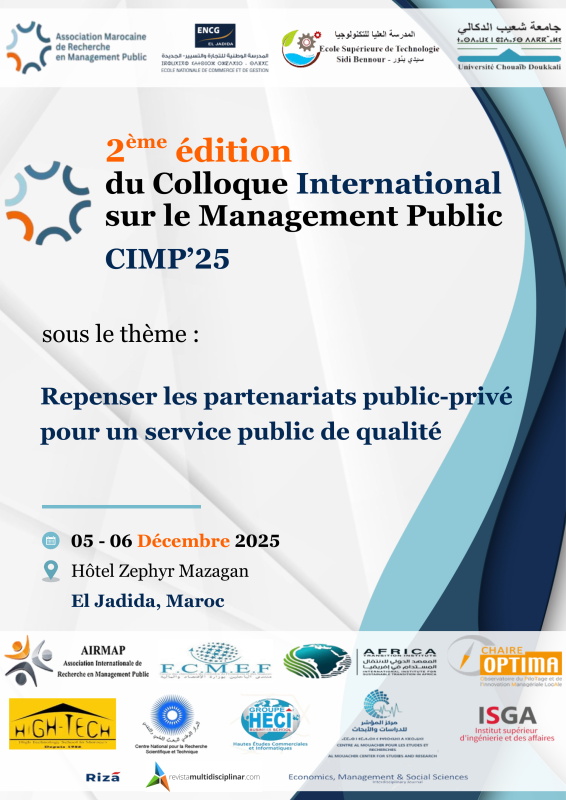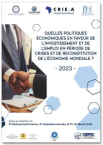Analysis of the possibility of moving to a new stage
in the process of flexibilization of the exchange rate regime in Morocco
DOI :
https://doi.org/10.23882/rmd.23131Mots-clés :
Exchange rate regime, exchange rate, flexibility, MoroccoRésumé
Given the profound structural changes in the national economy and its increasingly increased openness to the outside world, the transition to a more flexible exchange rate regime constitutes a fundamental reform in order to strengthen the competitiveness of the economy. its resilience to exogenous shocks and the level of its potential growth. However, the transition to more flexibility is not without risk, it would be accompanied by massive inflows of foreign capital motivated mainly by expectations of appreciation of the national currency and the interest rate differential, which will result in excess bank liquidity and excessive growth of reserves causing greater inflationary pressures and aggravation of financial fragilities and exchange rate risk. The objective of this article is therefore to question the capacity of the Moroccan economy through its macroeconomic fundamentals, its financial markets and its institutions, to support the transition to a new stage in the process of flexibilization of the exchange rate regime. The results show that this transition still has to wait, the ground needs to be further prepared.
Références
Ahmed, K., & Yahya, S. (2021). Contribution to the analysis of the Moroccan dirham exchange rate volatility: Econometric modeling using the asymmetric TGARCH model: Contribution à l’analyse de la volatilité du taux de change du dirham marocain: Modélisation économétrique à l’aide du modèle asymétrique TGARCH. African Scientific Journal, 3(4), 460. https://doi.org/10.5281/zenodo.5642815
Alhadj, M. S., Abessolo, Y. A., & Nemb, P. S. (2019). Régime de change et croissance économique: une investigation empirique à partir du rôle de la qualité des institutions. Global Journal Of Human-Social Science Economics, 19(1),7-18. http://bit.ly/3G5wqnP
Bank Al Maghrib (2015). Report presented to His Majesty the King. Financial year 2015.P91. http://bit.ly/3KmomkW
Bank Al Maghrib (2017). Exchange rate reform. Press Workshops, February 13. http://bit.ly/3TWjfLq
Camara, Y. (2014). Exchange Rate Regimes and Economic Performance in Sub-Saharan Africa (pp. 194-196). HAL Archives ouverts.com, December 2014. https://www.semanticscholar.org/author/Y.-S.-Camara/2094193097
De Mourat, R., Ocnarescu, I., Renon, A. L., & Royer, M. (2015). Méthodologies de recherche et design: un instantané des pratiques de recherche employées au sein d’un réseau de jeunes chercheurs. Sciences du design, (1), 68-75. https://doi.org/10.3917/sdd.001.0068
El Yamani, K., Charef, F., Qafas, A., & Jerry, M. (2018). Evolution of the management of the exchange rate regime in Morocco: what macroeconomic effects? International Journal of Business & Economic Strategy (IJBES), 8, 85-91. http://ipco-co.com/IJBES/vol8/161.pdf
EL Yamani, K., Qafas, A., & Jerry, M. (2021). Liens entre le taux de change et la croissance économique au Maroc : une approche économétrique en équations simultanées. International Journal of Accounting, Finance, Auditing, Management and Economics, 2(6-1), 247-270. https://doi.org/j4k3
Esaka, T., (2010). De facto exchange rate regimes and currency crisis: are pegged regime with capital account liberalization really more prone to speculative attacks? Journal of Banking & Finance, 34(6), 1109-1128. https://doi.org/10.1016/j.jbankfin.2009.11.007
Esmak, H. (2016). Prospects for an exchange rate regime in Morocco: towards greater flexibility. IOSR Journal of Economics and Finance (IOSR-JEF), 7(2), 120-136. https://bit.ly/3JM7zpY
Hefnaoui, A., & Iaataren, I. (2022). Débat théorique sur le choix du régime de change: Retour sur l’opposition fixeflexible. International Journal of Accounting, Finance, Auditing, Management and Economics, 3(4-2), 202-214. https://doi.org/10.5281/zenodo.6944353
Henri-Louis, V. (2019). Fixed exchange rate/floating exchange rate, the case of Morocco. Policy Center, September, PB-19/29, page 2. http://bit.ly/3KlrIEQ
IMF Fiscal Monitor (2017). Achieving More with Less, April Edition.
IMF Fiscal Monitor (2021). Annual Report on Exchange Arrangements and Exchange Restrictions. https://doi.org/10.5089/9781513598956.012
Jouamaa, Y., & Rhiati, Z. (2021). L’impact du cours de change sur l’inflation : cas du Maroc. Revue Internationale Des Sciences De Gestion, 4(1). https://www.revue-isg.com/index.php/home/article/view/523
Mezen, M., & Echkoundi, M. (2020). Morocco's adoption of the floating exchange rate: motivations, prerequisites and transition strategy. Finance & International Finance, N°18 January. https://doi.org/j4k4
Nakatani, R. (2018). Real and financial shocks, exchange rate regimes and the probability of a currency crisis. Journal of Policy Modeling, 40(1), 60-73. https://doi.org/10.1016/j.jpolmod.2017.10.004
Sabar, B., & Belhouari, I. (2018). Determination of exchange rate misalignments: the case of Morocco. Final project, INSEA, page 21.
Sylviane, G. J. (2019). Les enjeux de la réforme du régime de change du Maroc. https://hal.science/hal-02287908
Téléchargements
Publiée
Comment citer
Numéro
Rubrique
Licence
(c) Tous droits réservés Ahmed Hrifa 2023

Ce travail est disponible sous licence Creative Commons Attribution - Pas d’Utilisation Commerciale 4.0 International.







